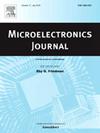Parasitic-induced multi-zero generation and port-fusion compact filter based on 3-D through-silicon via technology
IF 1.9
3区 工程技术
Q3 ENGINEERING, ELECTRICAL & ELECTRONIC
引用次数: 0
Abstract
A approach to achieving compactness and performance enhancement in lowpass filter (LPF) is described in this work. By leveraging the parasitic inductance of metal interconnects as inductive components, the proposed approach significantly reduces the overall size of the filter. Additionally, the combined effect of parasitic inductance and source-load coupling parasitic capacitance is utilized to create multiple transmission zeros, leading to improved isolation and wider bandwidth. Furthermore, a port fusion technique is introduced, which reduces the number of ports, minimizing interconnect losses and further enhancing compactness. The proposed LPF occupies a compact space of 0.31 × 0.34 mm2, features a cut-off frequency of 6.31 GHz, achieves an insertion loss of 30 dB at 30 GHz, and maintains a return loss below 0.4 dB.
基于三维硅通孔技术的寄生诱导多零产生和端口融合紧凑滤波器
本文描述了一种实现低通滤波器(LPF)紧凑性和性能增强的方法。通过利用金属互连的寄生电感作为感应元件,所提出的方法显着减小了滤波器的总体尺寸。此外,利用寄生电感和源负载耦合寄生电容的联合效应来产生多个传输零点,从而提高隔离性和更宽的带宽。此外,介绍了一种端口融合技术,减少了端口数量,减少了互连损耗,进一步提高了紧凑性。该LPF占用0.31 × 0.34 mm2的紧凑空间,截止频率为6.31 GHz,在30 GHz时实现30 dB的插入损耗,并保持低于0.4 dB的回波损耗。
本文章由计算机程序翻译,如有差异,请以英文原文为准。
求助全文
约1分钟内获得全文
求助全文
来源期刊

Microelectronics Journal
工程技术-工程:电子与电气
CiteScore
4.00
自引率
27.30%
发文量
222
审稿时长
43 days
期刊介绍:
Published since 1969, the Microelectronics Journal is an international forum for the dissemination of research and applications of microelectronic systems, circuits, and emerging technologies. Papers published in the Microelectronics Journal have undergone peer review to ensure originality, relevance, and timeliness. The journal thus provides a worldwide, regular, and comprehensive update on microelectronic circuits and systems.
The Microelectronics Journal invites papers describing significant research and applications in all of the areas listed below. Comprehensive review/survey papers covering recent developments will also be considered. The Microelectronics Journal covers circuits and systems. This topic includes but is not limited to: Analog, digital, mixed, and RF circuits and related design methodologies; Logic, architectural, and system level synthesis; Testing, design for testability, built-in self-test; Area, power, and thermal analysis and design; Mixed-domain simulation and design; Embedded systems; Non-von Neumann computing and related technologies and circuits; Design and test of high complexity systems integration; SoC, NoC, SIP, and NIP design and test; 3-D integration design and analysis; Emerging device technologies and circuits, such as FinFETs, SETs, spintronics, SFQ, MTJ, etc.
Application aspects such as signal and image processing including circuits for cryptography, sensors, and actuators including sensor networks, reliability and quality issues, and economic models are also welcome.
 求助内容:
求助内容: 应助结果提醒方式:
应助结果提醒方式:


